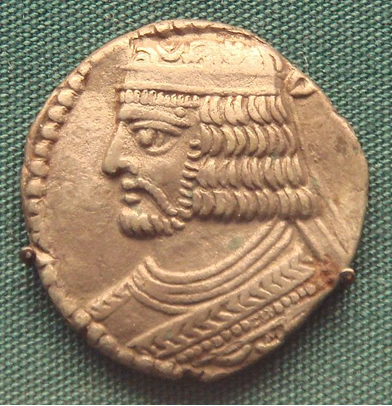|
"What in Goddamn Hell. . . ?"
On August 29, 1924, four newly minted ensigns fresh out of Annapolis – among them Hanson W. Baldwin, later a famous New York Times war correspondent – arrived at dockside in Hampton Roads, Virginia, to take up their first assignment in the Navy, aboard the battleship Texas (BB-35).
Naturally, they reported to the ship by the book, properly turned out in dress whites, with gloves and swords.
Boarding the ship, they reported to the Executive Officer, who took one look at them and bellowed, “What in goddamn hell have you got all that silly stuff on for? Take it off and get over the side into the coal barges and help coal the ship”, thus unceremoniously introducing them to what was undoubtedly the most detested duty in the fleet.
The Royal Warts of Parthia
Around 250 BC, Arasces, the leader of the Parni, an Iranic tribe, established himself as ruler of Parthia, a break-away province of the Hellenistic Seleucid Empire in what is now Iran. This initiated a line of some 50 kings who built Parthia into an empire that at its peak stretched from the Mediterranean to the Indus. A rival to Rome, the Parthians defeated an invasion by Marcus Licinius Crassus at Carrhae in 53 BC and another by Mark Antony in a protracted war in 40-33 BC, during which their King Pacorus I was killed in action. The Romans, in turn, got their licks in, probably winning more often than not. Indeed Ctesiphon, the Parthian capital, was several times taken and sacked by the Roman, such Trajan during his campaign of AD 113-116, Lucius Verus in 161-165, Septimius Severus in 195-197, and Carus in 283. Despite these, and many other less famous campaigns, neither Rome nor Parthia was ever able to gain more than a temporary advantage over the other superpower of the age, a situation that would continue in four centuries of warfare between the Romans and the Persians, who finally overthrew the Parthians in AD 228.
Like most monarchs, the Arascid kings of Parthia, a number of whom were notable warriors, liked to adorn their coins with their own images, just to let their subjects know who was boss. Interestingly, surviving specimens of these coins reveal that from the accession of Mithridates II in 121 BC the Arascid kings suffered from a noticeable genetic defect, known as trichoepithelioma.
Trichoepithelioma is a benign tumor that usually appears on the forehead, near the nose, or just in front of the ear, often showing up in middle age. From Mithridates II to the end of the Parthian Empire, the coins of eighteen kings show evidence of trichoepithelioma: either the wart itself or a curious arrangement of the hair that suggests that it is covering up something.
- Mithridates II (123-88 BC)
- Orodes II (57-37 BC), and his brother and co-ruler
- Mithridates III (57-54 BC)
- Pacorus I (38-37 BC)
- Phraates IV (37-c. 2 BC)
- Phraataces (c. 2 BC-AD 4)
- Vonones I (AD 8-12)
- Artabanus III (AD 10-38)
- Vardanes I (AD c. 38-45), and his brother and rival,
- Gotarzes II (AD c. 40-51)
- Volagases I (AD 51-78)
- Volagases II (AD 78-80)
- Pacorus II (AD 80-105)
- Volagases III (AD 105-116, 117-147)
- Parthamaspates (AD 116-117)
- Volagases IV (AD 147-191)
- Volagases V (AD 191-208)
- Volagases VI (AD 208-228)
That the coins even show the kings with trichoepithelioma is unusual, since during most of history royal persons are usually depicted as nearly perfect specimens of humanity, and often ageless as well. Itís possible that the trait was so well-known it helped lend legitimacy to the king, showing that he was indeed a kinsman to his predecessor, even if he had bumped the guy off.
 |
| Coin of King Volagases I of Parthia, with a noticeable “wart” above the left corner of his eye, suggesting Trichoepithelioma.
(Courtesy Wikipedia) |
Of the remaining kings, the surviving coins of five do not show evidence of trichoepithelioma, which could mean there was none, or they were being careful about their image (though this seems unlikely). As for the rest, either no coins have survived or those that do are too badly damaged to serve as evidence.
Note, by the way, the actual dating for Arascid history is somewhat shaky, given serious difficulties in reconciling the Roman calendar and the Parthian one, not to mention the Arascid penchant for staging coups, civil wars, and assassinations in order to usurp the throne from one another.
|